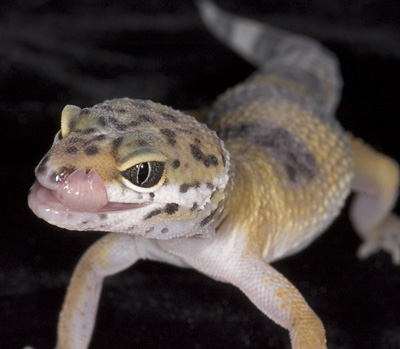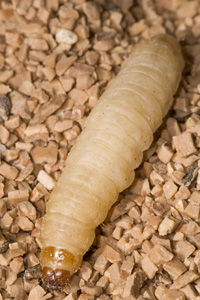|
Leopard Gecko
Best viewed with Internet Explorer |
||||||||||||||||||||
By Bruno Daniel Bertoni
|
||||||||||||||||||||
 |
||||||||||||||||||||
|
||||||||||||||||||||
| Description: The adult male is larger and more robust than the female. When healthy, the tail will be 3/4 the size of the neck giving the illusion of another head to protect the gecko from predators. The gecko will also shed its tail as a defense mechanism. The tail separates from the body and surrounding muscles. The muscles then constrict the artery in the tail to prevent unwanted blood loss and the tail will eventually regenerate. Skin color can vary, usually consisting of dark brown spots on white or yellow background. Juveniles have alternating bands of color running down their body and usually break up into spots or splotches during maturation. | ||||||||||||||||||||
| Life cycle: Leopard geckos are nocturnal reptiles; they become active at twilight or before sunrise. Daylight hours are spent out of the heat of the sun in a burrow or under a rock. They are ectothermic (cold-blooded) meaning that they absorb the heat they need for metabolic survival from outside sources. Optimal daytime temperatures should usually be around 85 degrees. The species reaches sexual maturity at one year of age. The sex of hatchlings is determined by temperature. | ||||||||||||||||||||
| Handling: If you pick up or threaten the gecko, it will cause the gecko to shed its tail causing unwanted stress on the animal. | ||||||||||||||||||||
| Housing: A terrarium with natural material, such as sand or gravel, is the ideal microhabitat. The gecko may ingest unnatural material causing death. A variance in temperature across the cage will allow the gecko to regulate its own body temperature. This can be accomplished through the use of a basking lamp at one end during the daytime hours and a reptile-heating pad during the night. They should receive equal amounts of light and dark. Calcium and vitamin supplements will insure a healthy, long living gecko. A hiding box or hollow structure will allow them to escape and feel secure and calm. Young geckos or juveniles can be feed daily and adults every other day. | ||||||||||||||||||||
 |
||||||||||||||||||||
|
|
||||||||||||||||||||
| |
||||||||||||||||||||
|
Photographing The Gecko
|
||||||||||||||||||||
| Making Good Light: The first problem often encountered while photographing this type of subject is the animal's need to control its own body temperature. Normal tungsten lighting over heated the animal and therefore could not be used. A variety of flash systems were attempted but ultimately the ring flash was chosen. It allowed for the most flexibility and, when not mounted directly to the lens, offered less harsh lighting. The ring flash also allowed the ability to freeze motion and keep the gecko at a cooler temperature. Keeping the environment at a lower temperature helps to slow the gecko down and makes it easier to handle. | ||||||||||||||||||||
|
Specimen Handling and Setup: A container should be used that is deep enough to prevent escape but shallow enough to obtain a side angle. The top of a medium-sized box, lined with natural bedding or black velvet, was used to contain the gecko. Experimenting with 2X4 blocks of wood and draping the velvet over the structure provided a clean background. Keeping an eye on both your subject and your surroundings is crucial to ensure the safety and health of the gecko. |
||||||||||||||||||||
|
Equipment: |
Camera
|
|||||||||||||||||||
|
Lens
|
||||||||||||||||||||
|
Ring Flash
|
||||||||||||||||||||
|
Specimen is a juvenile
female less than a year old.
|
||||||||||||||||||||
 |
 |
 |
||||||||||||||||||
|
This particular series
of shots was accomplished by turning down the room lights except for
one small light needed for focusing. The ring flash was mounted
directly on the front of the lens and fired sequentially. This caused
the gecko's iris to close, adjusting to the increase in light.
|
||||||||||||||||||||
 |
||||||||||||||||||||
|
The ability to freeze
motion was helpful to capture the natural behavior of the gecko. This
helps to illustrate how the gecko would act outside a photographic
setting.
|
||||||||||||||||||||
 |
||||||||||||||||||||
|
This photograph shows
the banding coloration of juveniles.
|
||||||||||||||||||||
 |
||||||||||||||||||||
|
It is crucial to ensure
when photographing live subjects that the eyes are in sharp focus.
|
||||||||||||||||||||
|
|
||||||||||||||||||||
|
Bruno Daniel
Bertoni is a senior graduating student enrolled
in the Biomedical Photographic Communications program at Rochester
Institute of Technology, with double minor in philosophy and Italian
language plus concentrations in ophthalmic photography and
photomacrography.
|
||||||||||||||||||||
|
Content and Photography
|
||||||||||||||||||||
|
Copyrighted by Bruno
Daniel Bertoni
|
||||||||||||||||||||
|
|
||||||||||||||||||||
|
Rochester Institute of
Technology
|
||||||||||||||||||||
Return to index of articles written by students on the 'Principles and techniques of photomacrography' course, November 2004, Biomedical Photographic Communications (BPC) program at the Rochester Institute of Technology (RIT).
Article hosted on Micscape Magazine (Microscopy-UK).

